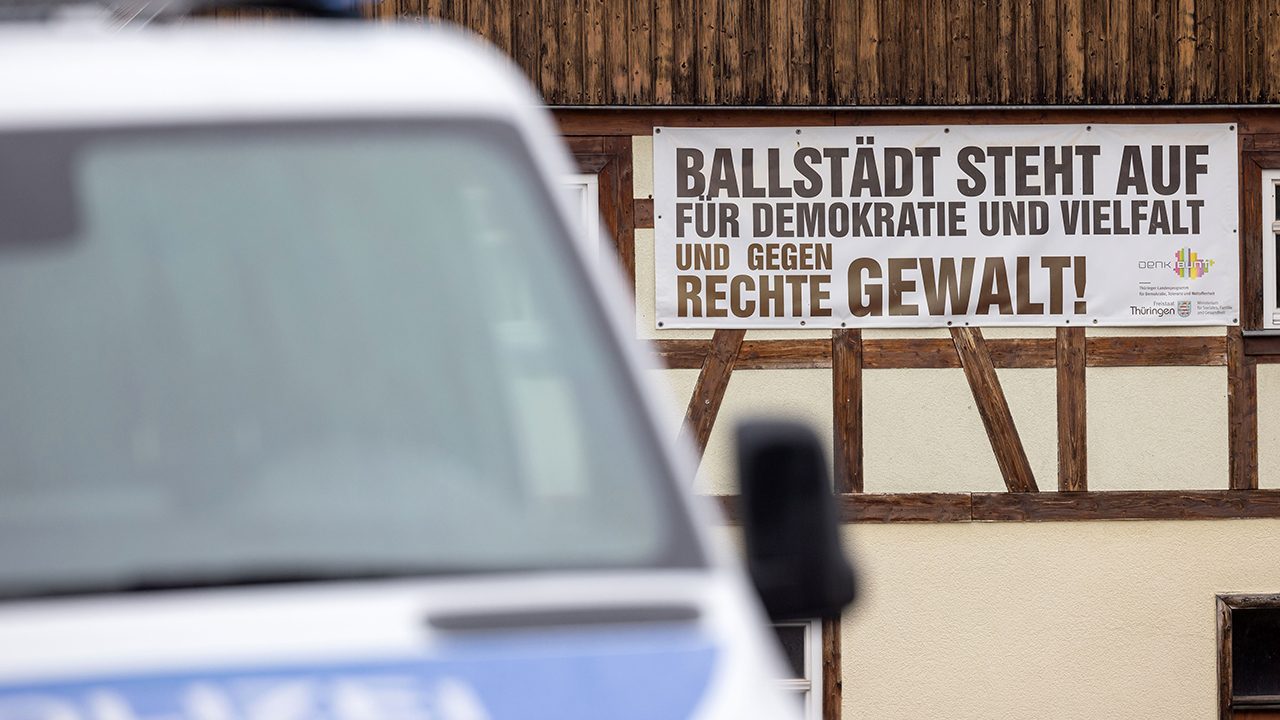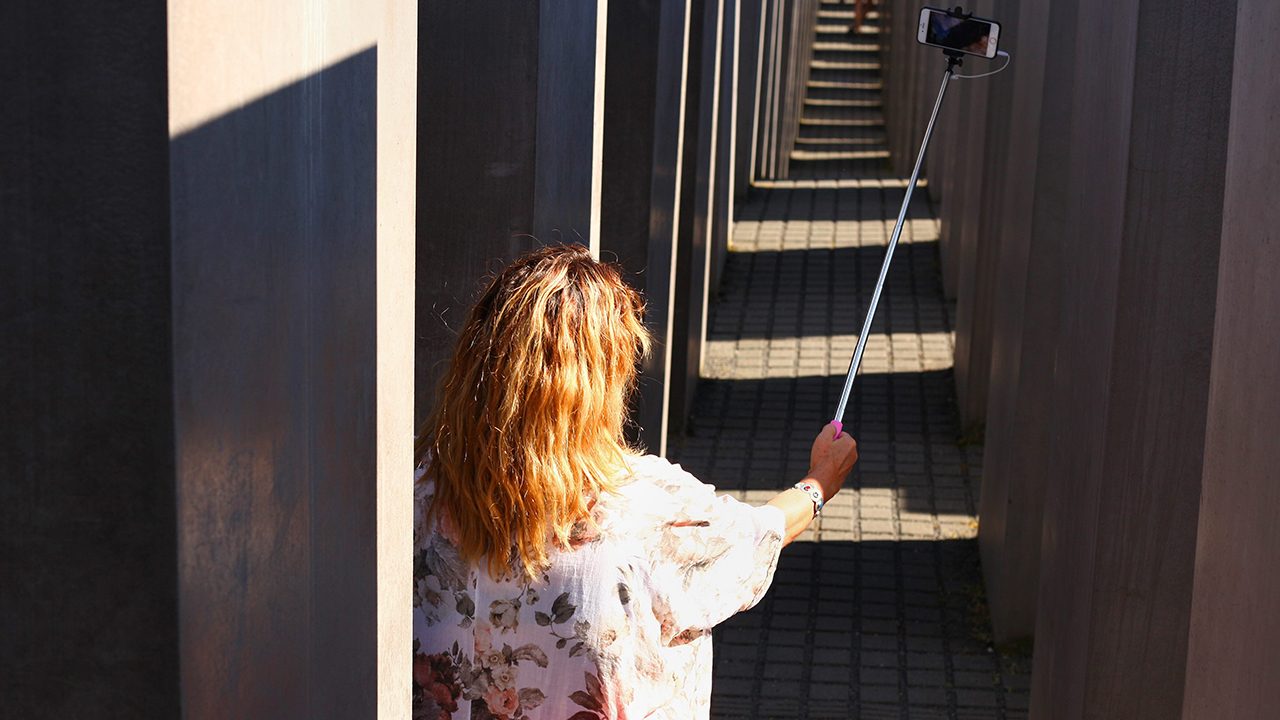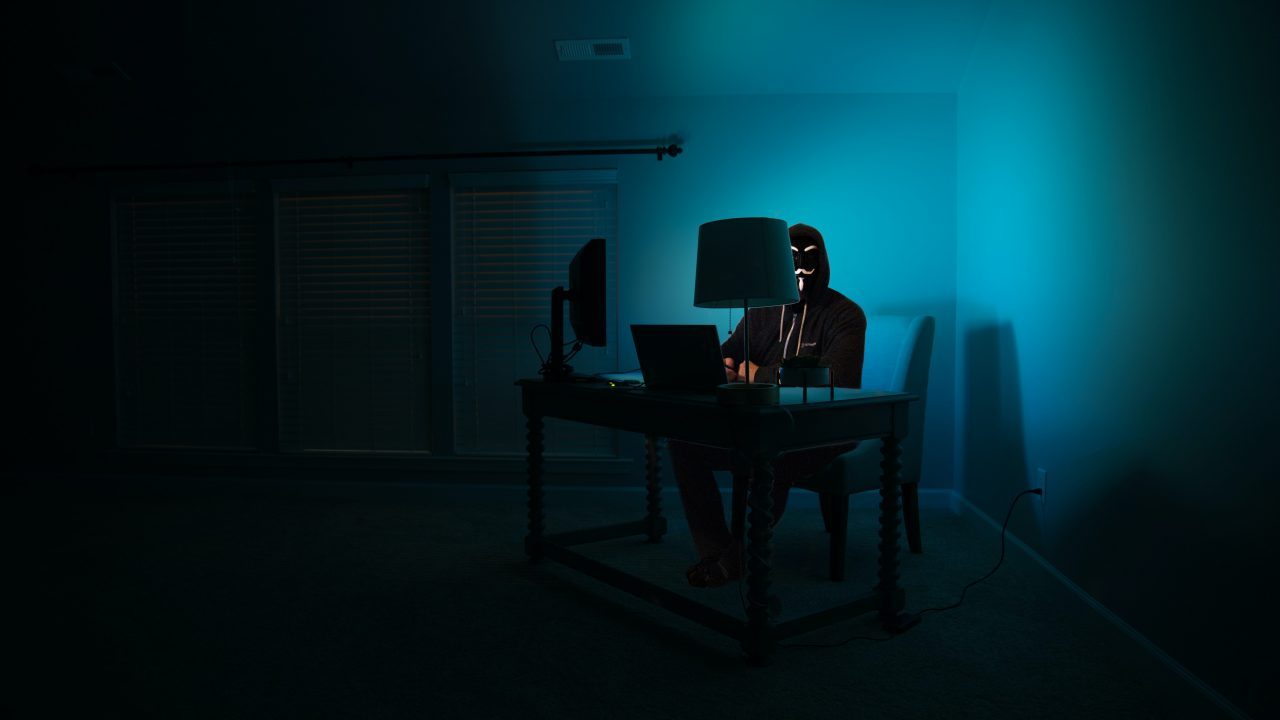
This article was originally published in German.
Shortly after a security meeting at the Berlin State Criminal Police Office at the end of January 2021, Ferat Kocak’s phone vibrated. He read the text message and felt afraid. It was a threat, not the first, but a serious one: he’s being watched, he shouldn’t “do anything un-German”, otherwise who knows what could happen, the message reads. Kocak’s fear is justified, because the local Die Linke (Left Party) politician and anti-fascist activist from Neukölln knows very well “what can happen”. On the night of February 1, 2018, neo-Nazis carried out an arson attack at Kocak’s home. At three o’clock in the morning, his car was set on fire and the flames spread to the house, almost reaching the adjacent gas pipe. If Kocak hadn’t woken up, he and his family could have died.
The alleged perpetrators had spied on Kocak for a year. Two weeks before the attack, Sebastian T., district leader in Neukölln of the far-right party NPD until late 2016, and Tilo P., then party officer of the Neukölln AfD, allegedly watched Kocak at a Linke party meeting in a café and followed him home. They now knew exactly where Kocak lived in the south of Neukölln. This information has come to light through investigation files, as the two neo-Nazis were being observed by Germany’s domestic intelligence service, the Office for the Protection of the Constitution, at the time. Kocak wasn’t warned. The authorities were more intent on protecting their sources rather than the victims.
Since then, the authorities have done surprisingly little. The investigations have been sluggish and characterised more by scandals and mishaps than successes. A big break has so far failed to materialise. Even a 30-person-strong special commission, the “Soko Fokus”, failed to produce any real results. In contrast, the alleged perpetrators have been far more active: since May 2016, 73 far-right crimes linked to the group have been registered in the district, including at least 23 arson attacks. Windows have been smashed, swastikas spray-painted, cars set on fire: the anti-fascist documentation project acoabo has depicted right-wing violence in the Neukölln on an interactive map – a cartography of terror.
The victims, almost exclusively people who are active against the far-right, speak of a series of terror in Neukölln. One of those affected is the social worker Christiane Schott. In November 2011, a cobblestone flew through her daughter’s bedroom window, six months later her letterbox exploded, and later still her car tires were slashed. Schott is disappointed with the results of the investigation. In February 2021, she told state broadcaster rbb: “They thank us for our commitment, yes. But the circumstantial evidence is not enough to arrest these people.” Or there’s Heinz Ostermann, owner of the local bookshop Leporello, whose shop windows were smashed in 2016 and whose car was set on fire. Thanks to crowdfunding, Ostermann was able to buy a new car, but that too was torched – on the night of February 1, 2018, the same night that Ferat Kocak was also a target of the far-right series of attacks in Neukölln. Although 34-year-old Sebastian T. and 37-year-old Tilo P., as well as Julian B., a neo-Nazi with a criminal record, are considered prime suspects for the series of attacks, the authorities’ do not have enough evidence sufficient for an arrest.
Enemy lists and open questions
However, there is already evidence, plenty of it: both neo-Nazis were caught red-handed in 2017 after spray-painting slogans such as “Murder of Hess” (a leading member of the Nazi Party), written with SS runes, and using a stencil to spray-paint the images of Hitler’s deputy. They are currently on trial for damage to property and the use of anti-constitutional symbols, with hearings still ongoing. In February 2018, Sebastian T.’s house was searched. A computer was confiscated, on which investigators initially found a suspected list of enemies with 30 names and addresses, including anti-fascist activists, politicians, journalists and police officers. Some of these people had already been victims of attacks and vandalism. Yet it wasn’t until one and a half years later, in November 2019, that investigators came across another data set on the computer with information on around 500 people. The file was in the recycling bin.
Those affected by the attacks have many questions. How did the neo-Nazis get the addresses of their victims? Was the data retrieved from police computers? Are there far-right networks within the Berlin police? What information about the investigations did police officers pass on to neo-Nazi circles in Neukölln? Which structures within the authorities abet right-wing crimes and prevent them from being solved? Did the intelligence services play a special role which is being prevented from being made public? Do intelligence services even have active informants in the orbit of the alleged perpetrators? So far, there have been few answers to these questions.
The investigation of the Neukölln attack series was at a standstill until August 2020, when an explosive press release from the Berlin Attorney General’s Office made national headlines: the investigation was to be taken over by Attorney General Margarete Koppers personally, and the investigation reexamined. The reason for this unusual step could possibly explain why investigators have had so little success so far. Circumstances had allegedly come to light “which make the bias of a public prosecutor appear possible”, according to the press release. A down-right scandal in the executive branch, almost without precedent. Two prosecutors were immediately withdrawn from the investigations into the Neukölln arson series and transferred to other departments.
According to media reports, one of the two prosecutors in question is the head of the State Protection Department, Mr. F., who is responsible for politically motivated crimes in Berlin. Prosecutor F. is known for being particularly tough on anti-fascist protest. He is now accused of being close to the neo-Nazi Tilo P., while Prosecutor S. is said to have known about this and did not intervene. Specifically, the report discussed the transcript of an intercepted telephone conversation between Tilo P. and Sebastian T., in which P. claims Prosecutor F. told him during an interrogation that he needn’t worry because F. himself was an AfD voter or close to the AfD. Whether this is true or a wild allegation remains unclear. What is clear, however, is that the explosive information was not passed on to superiors but apparently “disappeared” into the piles of investigation files. That this information is now, finally, being taken into account, regardless of its veracity, and that the investigations are being reexamined, is an encouraging sign for victims. Ferat Kocak says: “I have a bit more hope. Things are finally moving.”
A lack of evidence
In the following months, “many pieces of the puzzle came together” in the investigation, according to the newspaper Tagesspiegel – pieces that apparently provide a more accurate picture of the series of attacks. On December 23, 2020 the case reached a surprising turning point when Tilo P. and Sebastian T. were arrested. The accusation: in addition to arson, T. is also alleged to have illegally applied for pandemic emergency aid for the self-employed. Tilo P. avoided pre-trial detention, but Sebastian T. spent Christmas behind bars and was only released after an appeal to the district court on January 22, 2021. In both cases, the results of the investigation are not sufficient for imprisonment, according to the 25th Criminal Division of the Berlin Regional Court. But the prosecution is still determined to bring charges against the two neo-Nazis.
One week later, on January 28 of this year, Ferat Kocak received the threatening text message. A coincidence? Kocak has grown too sceptical to believe in random occurrences since the attack on him. “Why would the text message come now, of all times, after I had been to the State Criminal Police Office?” He suspects that Sebastian T.’s release from custody a few days prior might have something to do with it. He wonders whether a police officer passed on information to the neo-Nazi scene. Or if one of the police officers themselves sent the text. He has no proof of this, only a deep-seated suspicion: “Something isn’t right here.” In light of the police’s involvement in the NSU 2.0 threats sent to politicians, celebrities and journalists, Kocak’s fear is well-founded. He promptly informed his lawyer and the State Criminal Police about the latest threat.
In the past year, Kocak has received ten such text messages, the previous one came four months ago. “They want to give me a signal: that they have not forgotten me, that I am under threat.” The text messages were sent via the website 5vor12.de, which allows users to send messages anonymously and free of charge. Threats from NSU 2.0 to politicians and celebrities were also sent from the website. Belltower.News approached the website for comment but the operators declined to give a response. Then, there are nightly threatening phone calls. Kocak now switches off his phone in the evening and uses a separate private number just for his closest friends and family. Why doesn’t he just change his number? “If I get a new number, I have to give it to the press and activists. That would make my political work more difficult, because I would have to keep changing it.”
Structures behind the men
The names of the alleged perpetrators, Sebastian T., Tilo P. and Julian B,. have been repeatedly mentioned in police reports and the press. However, Kocak warns against focusing on only a few individuals, as investigators have apparently done so far. Instead, he calls to expose and combat far-right structures in Neukölln – including those within the authorities themselves. Time and again there have been inconsistencies in the Neukölln attack series, time and again security services have been implicated.
For example, the police officer Detlef M., part of police precinct 65 in Treptow-Köpenick, which borders on the south of Neukölln, where a large part of the series of attacks took place. M. was in contact with Tilo P. in a Telegram group and via email, as the newspaper taz reported. Both men were members of the Neukölln AfD at the time (P. has since left the party after he was threatened with expulsion). In 2016, the two discussed whether Tilo P. should attend an event at the Leporello bookshop, the bookshop owned by Heinz Ostermann, which was attacked ten days later. An illegal data query on police systems pertaining to victims of the attack has also remained unexplained so far. It therefore comes as no surprise that said victims have less and less confidence in the authorities to provide results.
The structures behind Sebastian T. and Tilo P. have remained largely unexplored in the investigations. Ferat Kocak thinks this is a mistake: “When these Nazis are finally gone, the next ones will simply follow and continue to terrorise us.” A look at the political biographies of two of the main suspects shows that both neo-Nazis are well connected. T. was a leading member of the now disbanded group Nationaler Widerstand Berlin in the early 2010s before serving a prison sentence until May 2016. According to media reports and anti-fascist research, Tilo P. was also involved in violent neo-Nazi attacks dating back to 2003. After Sebastian T’’s release from prison, he was spotted with P. at a Neukölln AfD meet-up in September 2016, based on Facebook photos obtained by Belltower.News.
However, Sebastian T. has now apparently found a new political home with the neo-Nazi splinter party Der III. Weg (The Third Path). Photos seen by Belltower.News show T. wearing a party beanie as he distributes flyers and propaganda material for the Der III. Weg in letterboxes in December 2020. On February 2, 2021, another flyer campaign from the party followed in Neukölln’s Schillerkiez neighbourhood, as neighbours reported. The title of the flyer could hardly be more ironic: “Stop the left-wing terror in Neukölln”. While the membership of the Neonazi NPD is declining and the party is increasingly losing political relevance in the far-right spectrum, thanks in part to the rise of the AfD, Der III. Weg is becoming an attractive option for an increasing number of Berlin neo-Nazis, as shown by the participation of several former NPD activists in a march organised by Der III. Weg on October 3 in Berlin-Hohenschönhausen.
DIY politics
In the meantime, Ferat Kocak, like many victims, is campaigning for a parliamentary inquiry into the Neukölln attack series. “We’re calling for an investigation committee. The background details of these attacks are important to us.” The rank and file of Die Linke party shares this demand, but the parliamentary group has so far been unable or unwilling to commit to it in a coalition agreement with their coalition partners, the Greens and the SPD. Approached for comment by Belltower.News, Dr. Dirk Behrendt (Green Party), Berlin’s justice senator, did not wish to comment on a potential parliamentary inquiry. Interior Minister Andreas Geisel (SPD) also declined to answer a list of questions relating to an investigation committee in the Senate.
Kocak wants to put an end to this standstill. In September 2021, he will run for Berlin’s House of Representatives and stands a good chance of high spot on the party’s election list. He is also running as a direct candidate in the constituency in south Neukölln where neo-Nazis spied on and attacked him for years. When talking about his parliamentary ambitions, Kocak strikes a defiant tone: “If the Interior Minister can’t or won’t push through this parliamentary inquiry, then we, the people affected, will come to the parliament ourselves and try to make it happen.” Will every potential voter welcome his confrontational tone? “Some may say ‘he is too loud’. But I’m not a bureaucrat, I’m an activist. And I want to use this position as a representative to support social movements and anti-fascist struggles. The attacks on me have only increased my political activism.”


